Located near the centre of China, Chongqing (pronounced chong-ching) is a major flight hub. Flying from Beijing to Lijiang we had an eight hour wait in the modern but uninspiring Chongqing Jiangbei Airport. Rather than hang about in the lounge we decided to have a look round the town.
Typically for Chongqing, the weather was overcast – it’s known as the “Foggy City” for its 100 days of fog a year. This, coupled with one of the lowest annual sunshine totals in China to make a somewhat dreary looking place, livened up by the exceptionally spicy food created to keep the chills away.
Chongqing is the largest city in China, and its population of 31.4m is higher than Peru or Malaysia and approaching that of Canada. Chongqing is one of the four municipality towns in China, along with Beijing, Shanghai and Tianjin. Instead of being part of a province, these municipalities report directly to the national government.
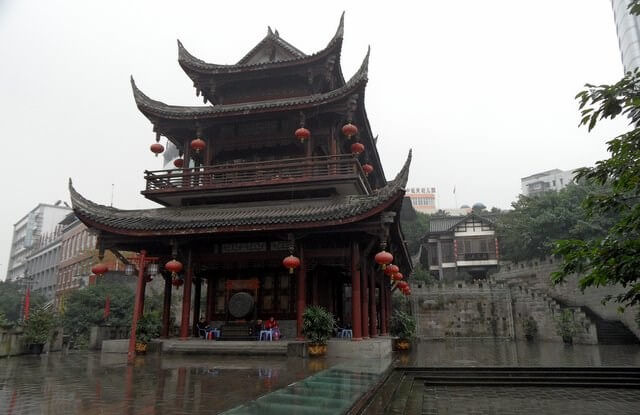
Chongqing Drum Tower
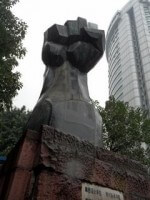 Just 45 minutes from the airport a taxi dropped us off at one of the highest points, an area called Tongyuanmen, which takes its name from the city gates at its centre. Atop these gates are the Drum Tower and a series of inscriptions explaining the history of the area dating back 2200 years.
Just 45 minutes from the airport a taxi dropped us off at one of the highest points, an area called Tongyuanmen, which takes its name from the city gates at its centre. Atop these gates are the Drum Tower and a series of inscriptions explaining the history of the area dating back 2200 years.
There’s also a huge bronze sculpture of a fist, commemorating a military coup in 1927. It’s very reminiscent of a Hand of Nod to anyone that spent their youth playing Command & Conquer.
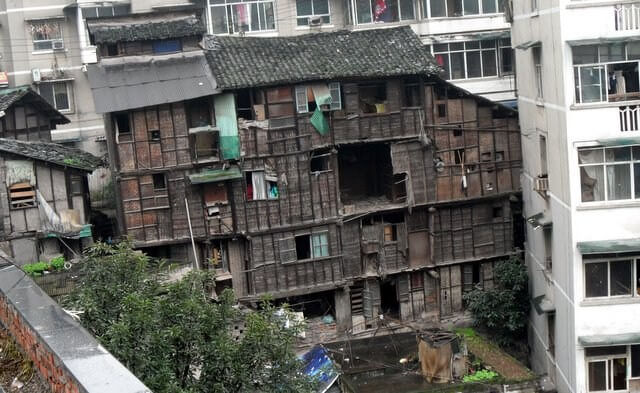
Chongqing Stilt House
Carrying on downhill, we reached a viewing area on the edge of a roundabout. From here, we could see the remnants of the old city and one of the last surviving Diaojiaolou, or stilt houses.
As the city is so hilly, the builders used varying lengths of stilt to create a larger floor area. These houses are often five or six levels high to maximise ground use and are a low-tech precursor to the skyscrapers that are so rapidly replacing them.
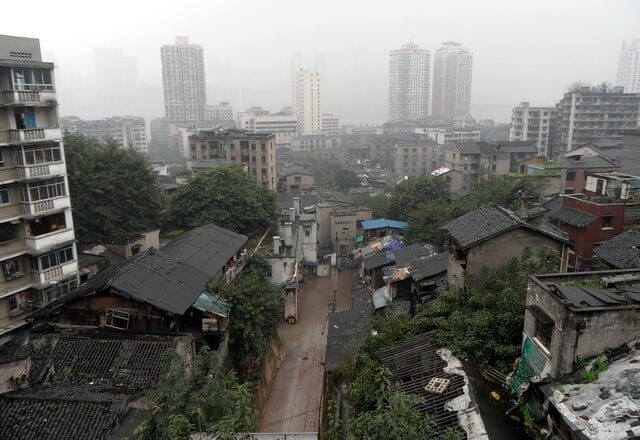
Looking out over Chongqing Old Town
The hilly nature of the city also led to it being unusual for its lack of bicycles, and may be why the oldest part of town centres on the Eighteen Stairs. This series of staircases was historically the fastest route from the Chaotianmen docks up the hill to the main town.
A human chain of people (known as BàngBàng, for the characteristic bamboo pole they carried over their shoulders) would carry goods (and rich people) up the stairs. Today, as then, hole-in-the-wall restaurants and repair shops line the stairs. The food here is cheap and the owners welcoming, making it hard to stick to our decision to try Chongqing hot pot in the area in which it was supposedly invented.
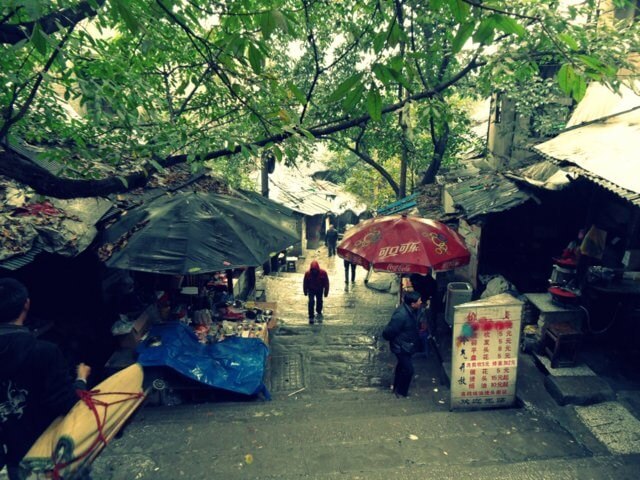
Eighteen Steps, in Chongqing
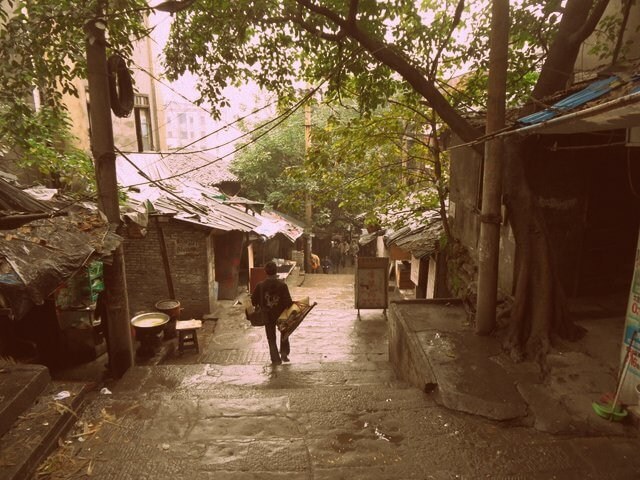
Chongqing, the Eighteen Stairs, with a filter to make the weather look a little sunnier.
Reaching the bottom of the Eighteen Stairs, we arrived at Chaotianmen Docks. The port is the meeting point of the jade green Jialing River and the muddy brown Yangzi River. Despite the cold and drizzly day the little plaza was full of old men flying kites and young couples taking wedding photos against the rather industrial background.
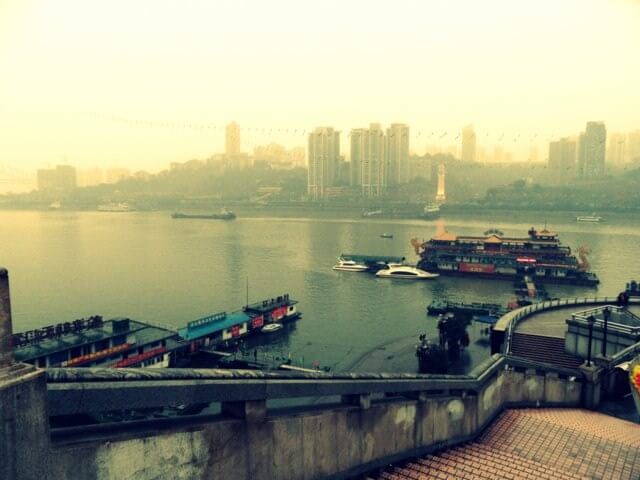
Chongqing Docks - looking near the white boats you can see the meeting of the two rivers with the green Jialing river on the left
(Modern?) Chinese wedding photos are somewhat different to those in the UK. Instead of our usual bunch of people standing to attention and staring at the camera, many Chinese couples seem keen on dressing all in white and taking posed action shots whilst skating or bowling, or simply staring at the sky in wonderment. These action shots are then placed against backgrounds of flowers and butterflies and the people airbrushed almost beyond recognition, which I’m not sure I like, so I was happy to see some better examples a few days later in Shuhe, near Lijiang.
Other options in Chongqing
Chongqing is notable as the launching point for the boat trips down the Yangtze River through the Three Gorges Dam.
Other things to do include the Chongqing Zoo (which is included on EVERY organised tour), the Three Gorges museum, or visiting the Buddhist Dazu Rock Carvings UNESCO World Heritage Site located three hours west of Chongqing City.









Pingback: Joann Pittman (@jkpittman)
Pingback: SeattleChineseGarden (@SeaChineseGrdn)
31 MILLION PEOPLE?!?! Oh gosh, I had no idea there was a city in China with more people than Shanghai! I think I have to visit it just for that fact alone! It does sound like an interesting place though other than the ridiculous population. A Chinese city with few bikes eh… Sounds crazy!
If only train tickets weren’t so hard to get now I’d probably head there for Spring Festival, but instead I’m stuck in Beijing..
I’d definitely recommend a visit. Despite the size, Chongqing has a far more relaxed feel than Beijing or Shanghai.
Wow, those are beautiful pictures! Gloomy, but pretty. Those stilt houses and Eighteen Stairs are going on my “to see” list.
The areas by the river are very attractive. I just wish we’d had more time to hang out on in the little restaurants on the Eighteen Steps.
Pingback: East Asia Blog Round-Up : 15/1/2012 | Eye on East Asia
Pingback: John and Andrea (@InspirngTrvlrs)
Pingback: Nancy Sathre-Vogel (@familyonbikes)
Pingback: Cam & Nicole (@travelcanucks)
I love this. I lived in Chongqing for a year and I miss it.
By the way, Chongqing isn’t in Sichuan; it’s an independent municipality (the same as Tianjin, Shanghai and Beijing).
Ah, thanks – I knew about the municipality status, but forgot it made the city fall outside of Sichuan.
Thinking about it I suppose my formal address is ‘Beijing Municipality’ and no mention of the surrounding province…
beautiful photos – it is incredible,. the stilt buildings next to modern concrete ones. old and new!
I was surprised – for such a rapidly expanding city there’s a surprising amount of old buildings left
Pingback: CityWorld (@CityWorldNow)
Pingback: Mr. Mike (@sweatyinbkk)
Pingback: @digidrift
Pingback: BlogExpat (@BlogExpat)
Pingback: Julian (@Ju1i4n)
Pingback: @SeaChineseGrdn
I always thought those hand of Nod structures in Command and Conquer were far to extravagant to exist in real life. The geek in me is happy that they do!